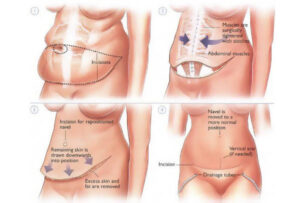 I am seeing more patients in my practice now, who have a lot of loose abdominal skin, than ever before. Traditionally, tummy tucks were performed on women, after childbearing age, who had a lot of loose skin. Because of the increased frequency of bariatric surgery i.e. gastric banding and gastric bypass, many patients have lost significant amounts of weight and now have loose skin. In those situations, it is not only the abdomen but also the arms, breasts, thighs, and even the back that are loose.Over the last 10 years, the number of abdominoplasties, performed by board-certified plastic surgeons, has increased from 34,000 to approximately 200,000. Women still outnumber men 40:1.
I am seeing more patients in my practice now, who have a lot of loose abdominal skin, than ever before. Traditionally, tummy tucks were performed on women, after childbearing age, who had a lot of loose skin. Because of the increased frequency of bariatric surgery i.e. gastric banding and gastric bypass, many patients have lost significant amounts of weight and now have loose skin. In those situations, it is not only the abdomen but also the arms, breasts, thighs, and even the back that are loose.Over the last 10 years, the number of abdominoplasties, performed by board-certified plastic surgeons, has increased from 34,000 to approximately 200,000. Women still outnumber men 40:1.
There are different techniques of abdominoplasty and an experienced board-certified plastic surgeon knows how to choose the right technique for the patient. In most cases, the patient not only has loose skin but also has some excess fat, particularly in the love handle and lower back area, as well as lower abdomen. They also have laxity of the abdominal muscles. All of these problems need to be addressed. To help flatten the abdomen effectively, the fascia directly overlying the rectus muscles is plicated, or sutured together to prevent the abdomen from distending. In addition, liposuctioning is done to a limited degree in the abdomen, as well as love handle and lower back as necessary.
The length of the incision and tightening of the musculature determines the difference between a “mini tuck” and a standard abdominoplasty. For the standard abdominoplasty, the muscles are usually tightened from just below the breast bone down to the pubic bone. For the mini tuck, all the work is done below the belly button or umbilicus. In the standard abdominoplasty, the skin and fat are elevated off the underlying muscle to the level of the ribs. The hips are then flexed on the operating table and the excess skin is pulled down. An opening is made in this skin flap and the belly button, which is preserved on its stalk, is then pulled up so that the belly button stays at the same position on the abdominal wall. In a mini tuck, the skin and fat are only elevated up to the level of the belly button and then the excesses are resected. In an extended abdominoplasty, the incision extends past the hip bone to also lift the thigh and the lateral hip at the same time as flattening the belly.
I explain to my patients that the length of the incision is not critical, as long as I can be hidden within the panty line.
Frequently Asked Question
- Traditional Tummy Tuck (Full Abdominoplasty): Involves a horizontal incision between the hipbones, allowing for correction of both lower and upper abdomen.
- Mini Tummy Tuck: Targets only the lower abdomen with a smaller incision, suitable for those with minimal excess skin and fat below the belly button.
- Extended Tummy Tuck: Extends the incision around the hips to address excess skin and fat on the sides (flanks) and lower back as well as the abdomen.
Ideal candidates generally include individuals who:
- Have excess skin or fat in the abdomen that doesn’t respond to diet or exercise.
- Have realistic expectations about the outcomes of the surgery.
- Are in good overall health without medical conditions that could impair healing.
- Anesthesia: Usually general anesthesia is used for a traditional tummy tuck, or sometimes local anesthesia with sedation for a mini tummy tuck.
- Incision: Depending on the type, an incision is made to remove excess skin and fat.
- Muscle Repair: Abdominal muscles may be tightened and repaired to enhance abdominal contour.
- Skin Redraping: The remaining skin is redraped and excess skin is trimmed.
- Closure: Incisions are closed with sutures, and sometimes drains are placed temporarily to collect excess fluids.
- Immediately After Surgery: Patients typically wear a compression garment to reduce swelling and support the abdomen.
- First Few Weeks: Rest and limited activity are advised; patients gradually resume normal activities over several weeks.
- Long-Term: Final results appear gradually as swelling subsides, usually within several months to a year.
- General Risks: Include bleeding, infection, and reactions to anesthesia.
- Specific Risks: Such as fluid accumulation, poor wound healing, numbness, and scarring.
- Long-term Risks: Potential for asymmetry, changes in skin sensation, or need for revision surgery.

